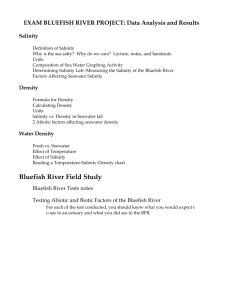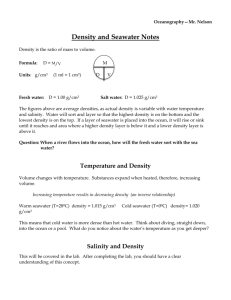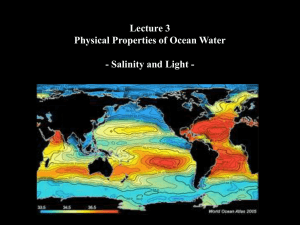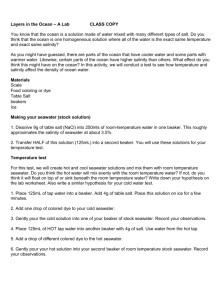TA vs DIC (sig)
advertisement
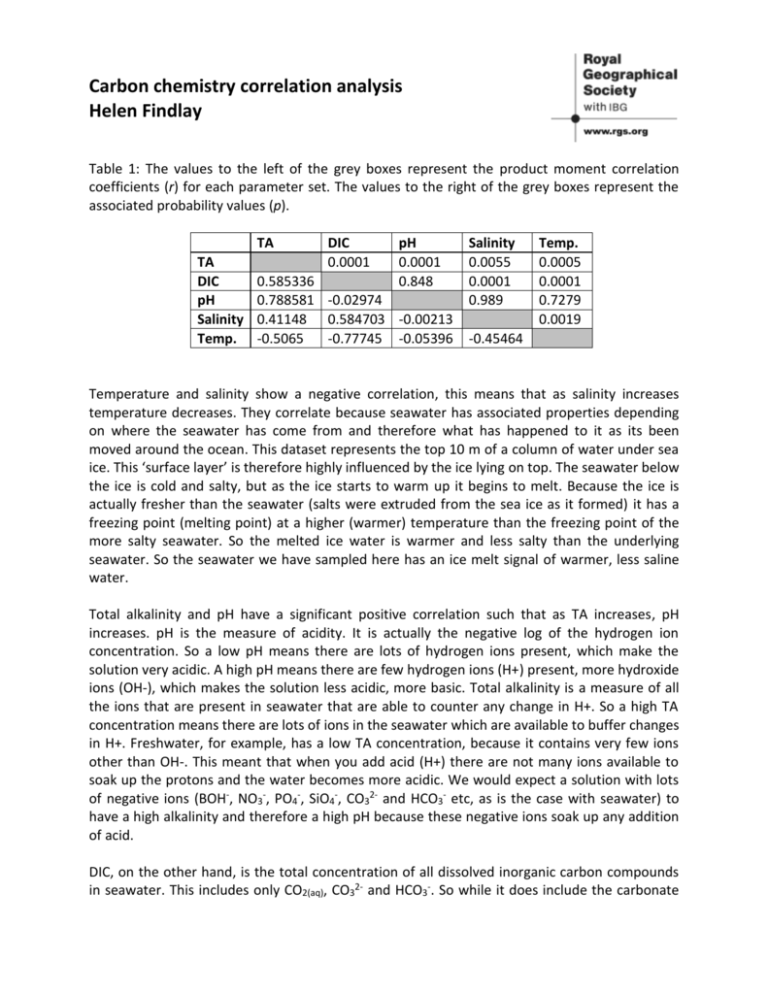
Carbon chemistry correlation analysis Helen Findlay Table 1: The values to the left of the grey boxes represent the product moment correlation coefficients (r) for each parameter set. The values to the right of the grey boxes represent the associated probability values (p). TA TA DIC pH Salinity Temp. DIC 0.0001 pH 0.0001 0.848 0.585336 0.788581 -0.02974 0.41148 0.584703 -0.00213 -0.5065 -0.77745 -0.05396 Salinity 0.0055 0.0001 0.989 Temp. 0.0005 0.0001 0.7279 0.0019 -0.45464 Temperature and salinity show a negative correlation, this means that as salinity increases temperature decreases. They correlate because seawater has associated properties depending on where the seawater has come from and therefore what has happened to it as its been moved around the ocean. This dataset represents the top 10 m of a column of water under sea ice. This ‘surface layer’ is therefore highly influenced by the ice lying on top. The seawater below the ice is cold and salty, but as the ice starts to warm up it begins to melt. Because the ice is actually fresher than the seawater (salts were extruded from the sea ice as it formed) it has a freezing point (melting point) at a higher (warmer) temperature than the freezing point of the more salty seawater. So the melted ice water is warmer and less salty than the underlying seawater. So the seawater we have sampled here has an ice melt signal of warmer, less saline water. Total alkalinity and pH have a significant positive correlation such that as TA increases, pH increases. pH is the measure of acidity. It is actually the negative log of the hydrogen ion concentration. So a low pH means there are lots of hydrogen ions present, which make the solution very acidic. A high pH means there are few hydrogen ions (H+) present, more hydroxide ions (OH-), which makes the solution less acidic, more basic. Total alkalinity is a measure of all the ions that are present in seawater that are able to counter any change in H+. So a high TA concentration means there are lots of ions in the seawater which are available to buffer changes in H+. Freshwater, for example, has a low TA concentration, because it contains very few ions other than OH-. This meant that when you add acid (H+) there are not many ions available to soak up the protons and the water becomes more acidic. We would expect a solution with lots of negative ions (BOH-, NO3-, PO4-, SiO4-, CO32- and HCO3- etc, as is the case with seawater) to have a high alkalinity and therefore a high pH because these negative ions soak up any addition of acid. DIC, on the other hand, is the total concentration of all dissolved inorganic carbon compounds in seawater. This includes only CO2(aq), CO32- and HCO3-. So while it does include the carbonate and bicarbonate ions that could potentially buffer pH, it also contains CO2 which can react with water to form more acid (and decrease the pH). We would therefore not expect there to be any correlation between pH and DIC. Temperature and salinity can influence the amount of ions that are present in seawater by diluting or concentrating the ions in the seawater (through processes such as evaporation, precipitation, ice freezing and melting). As TA and DIC are both measures of the concentration of these various ions that are present in seawater we would expect that TA and DIC are therefore influenced by, and therefore correlate with, both temperature and salinity. The correlations between temperature and DIC or TA are negative. So as temperature increases, DIC or TA decrease. Correlations between salinity and DIC or TA are positive, so as salinity increases, DIC or TA increase. As discussed briefly above, temperature and salinity can be used as markers of where the water has come from and what processes have occurred within it. So the fresh (less saline), warm water that was added from the melting ice, also has low concentrations of DIC and TA because when the seawater froze the ions within the seawater were also extruded from the sea ice. It is perhaps a little bit surprising that pH does not have a significant correlation with salinity or temperature, because TA and pH correlate, and TA correlates with both temperature and salinity. The most likely explanation is that there are other processes going on that contribute to pH more strongly than changes in temperature and salinity, which are not captured just by measuring the carbonate system parameters. TA and DIC show a significant positive correlation. This is not likely to be a cause and effect relationship but an unrelated correlation; a coincidence. We have seen that both DIC and TA are correlated with temperature and salinity in the same manner; therefore it is likely that the changes in temperature and salinity that were found in these water samples are responsible for the changes in DIC and TA, which respond in the same pattern.



